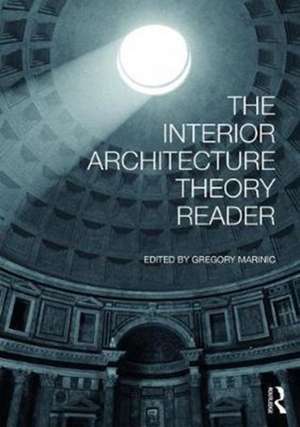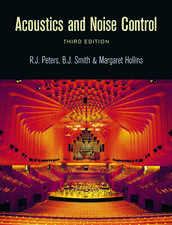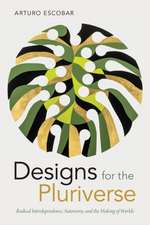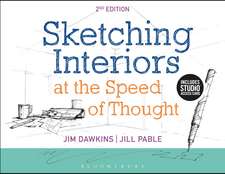The Interior Architecture Theory Reader
Editat de Gregory Marinicen Limba Engleză Paperback – 22 ian 2018
| Toate formatele și edițiile | Preț | Express |
|---|---|---|
| Paperback (1) | 249.44 lei 6-8 săpt. | |
| Taylor & Francis – 22 ian 2018 | 249.44 lei 6-8 săpt. | |
| Hardback (1) | 772.76 lei 6-8 săpt. | |
| Taylor & Francis – 23 ian 2018 | 772.76 lei 6-8 săpt. |
Preț: 249.44 lei
Preț vechi: 293.12 lei
-15% Nou
Puncte Express: 374
Preț estimativ în valută:
47.73€ • 49.98$ • 39.59£
47.73€ • 49.98$ • 39.59£
Carte tipărită la comandă
Livrare economică 09-23 aprilie
Preluare comenzi: 021 569.72.76
Specificații
ISBN-13: 9781138911086
ISBN-10: 1138911089
Pagini: 476
Ilustrații: 254
Dimensiuni: 174 x 246 x 26 mm
Greutate: 0.86 kg
Ediția:1
Editura: Taylor & Francis
Colecția Routledge
Locul publicării:Oxford, United Kingdom
ISBN-10: 1138911089
Pagini: 476
Ilustrații: 254
Dimensiuni: 174 x 246 x 26 mm
Greutate: 0.86 kg
Ediția:1
Editura: Taylor & Francis
Colecția Routledge
Locul publicării:Oxford, United Kingdom
Public țintă
Postgraduate, Professional, and UndergraduateCuprins
Part 1: Histories 1. (Re)constructing Histories: A Brief Historiography for Interior Architecture Edward Hollis 2. Quadratture: The Joining of Truth and Illusion in the Interior Architecture of Andrea Pozzo Jodi La Coe 3. Spatial Therapies: Interior Architecture as a Tool for the Past, Present, and Future Ziad Qureshi 4. Inside Out Michael Webb 5. A History of Style and the Modern Interior: From Alois Riegl to Colin Rowe Sarah Deyong 6. Symbiotic Spaces: Decolonizing Identity in the Spatial Design of the Museum of Macau Emily Stokes-Rees Part 2: Territories 7. Shape Shifting: Interior Architecture and Dynamic Design Mark Taylor 8. Politicizing the Interior Liz Teston 9. Fabricating Interiority Marc Manack 10. Territory and Inhabitation Amy Campos 11. Swimming Upstream: Repositioning Authorship and Expanding the Agency of the Architect Blair Satterfield and Marc Swackhamer Part 3: Spatialities 12. Inside Looking In: The Prospect of the Aspect Ursula Emery McClure & Michael A. McClure 13. The Waiting Room: Transitional Space and Transitional Drawing Susan Hedges 14. Spatial Seductions: The Everyday Interiorities of Marcel Duchamp, Edward Kienholz, and Pepón Osorio Pablo Meninato 15. Inside the Prefab House Deborah Schneiderman 16. Oceanic Interiorities Sarah Treadwell 17. Technologies: The Spatial Agency of Digital Praxis Erin Carraher 18. Transforming Interior Volumes: Volume + Surface + Mass Jonathon R. Anderson and Laura Lovell-Anderson Part 4: Sensoralities 19. Sensorial Interior Landscapes Laura Garófalo-Khan 20. From Ambient Environments to Sentient Spaces Nataly Gattegno & Jason Kelly Johnson 21. Design Studio through the Subtle Revelations of Phenomenology Ross T. Smith 22. Lines of Enquiry: Drawing Out Sigmund Freud’s Study and Consulting Room Ro Spankie 23. On Limits Clare Olsen 24. Salvador Dalí’s Interiors with Heraclitus’s Concealment Simon Weir 25. Touch, Taste, Smell: Fostering Museum Visitor Engagement with Multi-Sensory Spaces Kirsten Brown Part 5: Temporalities 26. Pirouetting on the Orthographic Hinge Lois Weinthal 27. Toward the Immaterial Interior Frank Jacobus 28.Time Travel: Interior Architecture and the Exhibition Space Anne Massey 29. Sounding Out Vacancy: Performing (anything but) Empty Space Julieanna Preston 30.Productions: Spatial Practices, Processes, and Effects Clay Odom Part 6: Materialities 31. "Living" Rooms: The Hyper Naturalization of the Interior Blaine Brownell 32. Inside-out and Outside-in: The Envelope and the Search for a Heterogeneous Interiority Marco Vanucci 33. Measuring the Human Dimension: Domestic Space, Materiality, and Making in Japan Zeke Leonard 34. Internal Disconnect: Material Memory in the John Portman Originals Gregory Marinic Part 7: Occupancies 35. To Dwell Means to Leave Traces: Modernism, Mastery, and Meaning in the House Museums of Gaudí and Le Corbusier Georgina Downey 36. Event-Space: A Performance Model for Spatial Design Dorita Hannah 37. Documenting Interiority / Inhabiting Duration Marian Macken 38. Topology and Interiority: Folding Space Inside Johan Voorduow 39. Architectural Purgatory: The Car, the Garage, and the House Anthony Morey and Volkan Alkanoglu 40. Spacing and Forming: A Performative Account of a Design Studio Jan Smitheram Part 8: Appropriations 41. Death of the Architect: Appropriation and Interior Architecture Markus Berger 42. The Dialectics of Appropriation Graeme Brooker 43. Puzzle Rachel Carley 44. Metropolitan Hybrids: Programing for a Thriving Urbanity Rafael Luna 45. Design Activism: Commingling Ethics of Care and Aesthetics Lorella Di Cintio 46. Beyond the Visible: Skillsets for Future Interior Architecture Practice Caryn Brause Part 9: Globalities 47. Interiors as Global Constructs: Framing Culture and Design Discourses in a World of Movement Tasoulla Hadjiyanni 48. Hearts and Minds and Dishwashers Jodi Larson 49. Public Spheres: Hong Kong’s Interior Urbanism Jonathan D Solomon 50. Altered (E)states: Alteration and Adaptation in Architecture and its Interiority David Erdman
Notă biografică
Gregory Marinic, PhD, is a designer, theorist, scholar, and educator whose research and practice are focused on the intersection of architecture, interiority, obsolescence, adaptive reuse, and geography. His New York-based multidisciplinary design practice, Arquipelago, has been awarded by the Seoul Metropolitan Government, American Institute of Architects, and the Association of Collegiate Schools of Architecture; as well as exhibited in the AIA Center for Architecture in New York, Estonian Architecture Museum in Tallinn, Seoul Dongdaemun Design Plaza, TSMD Architecture Center in Ankara, National Building Museum in Washington, D.C., and elsewhere. His critical essays have been published in AD Journal, Journal of Architectural Education, Design Issues, Journal of Interior Design, AIA Forward Journal, International Journal of Architectural Research, and Int|AR Journal of Interventions and Adaptive Reuse. Dr. Marinic is an associate professor at the University of Kentucky College of Design and Director of Graduate Studies in the School of Interiors. He previously served as founding director of the Interior Architecture program at the University of Houston College of Architecture and Design.
Descriere
With fifty essays authored by leading educators, theorists, academics and practitioners from Europe, the Americas, Australia, New Zealand and Asia this book provides both multiplicity and continuity to the reader, defining and examining the reader’s understanding of interior architecture.










